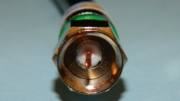So, you’re having trouble wrapping your head around it. DIRECTV’s SWM system allows one wire to each receiver no matter how many tuners. It’s different from the old system where you needed one wire for each tuner and each wire had to go straight to the multiswitch. SWM lets you use splitters, although they have to be special ones. How does it all work?
The easiest way to understand SWM is to think of it as a modulator system. A DIRECTV dish can send four types of signals down the line, but it can only send one type at a time. Using four signal types allows for a massive amount of information to be available, far more than you could get over a single line.
In every DIRECTV receiver there’s a lookup table that lets it know which of the four signals a particular channel is on. If you tune to ESPN, the receiver would have to know that (for example) it’s on 13V odd, which is one of the four signal types. In a non-SWM system, the receiver makes a request to the dish or multswitch which provides that specific signal to the receiver. The receiver then tunes in that signal and finds the part that corresponds to ESPN. The fact that you can’t have more than one signal type on a wire is the reason that an old-school system needs one wire per tuner. If the receiver needed to tune two different kinds of signals to record two channels, you’d only get one if you only have one wire.
SWM changes that. With a SWM system, it’s like a little modulator putting out eight channels. There are also other signals that go back and forth, but for now we’ll concentrate on the video part of it. When tune to a channel on a SWM system, it still needs to know what kind of signal it needs, but instead of getting that signal over the wire, the specific part of the signal you need — just the ESPN part for example — is modulated and put on a specific frequency. There are 8 different frequencies in a regular SWM (13 in a SWM-13) so 8 channels can be tuned on a single wire. The SWM is always receiving the full set of four signals from the dish, so it can easily provide just the parts the receivers need.
Because it’s essentially a modulated system, SWM can be very flexible in ways that a non-SWM system can’t be. Splitters can be used because all eight channels are going out to every location, all the receiver needs to do is tune to one of them.
What about that other stuff? There’s a ninth channel which is used for guide data, plus a control channel that goes from the receivers to the SWM which lets the system know what the receivers need. There’s also the MoCA channel which is used for on demand and also to provide video to the Genie Mini Clients. It’s a very complex system and the real key to it is that all the signals travel on that wire one different frequencies so they don’t disturb each other. It’s kind of ingenious if you think about it.
Unfortunately, DIRECTV SWM systems are different from other satellite systems so you do need special equipment to make them work. In the past it was easier to use different components side-by-side with a DIRECTV system, but SWM makes it harder. For example, there was a time when it was common to put over-the-air antenna signals on the same wire as DIRECTV satellite signals, but the frequencies used by over-the-air are also the same ones used by DIRECTV’s MoCA signal so it’s no longer possible to do that.





